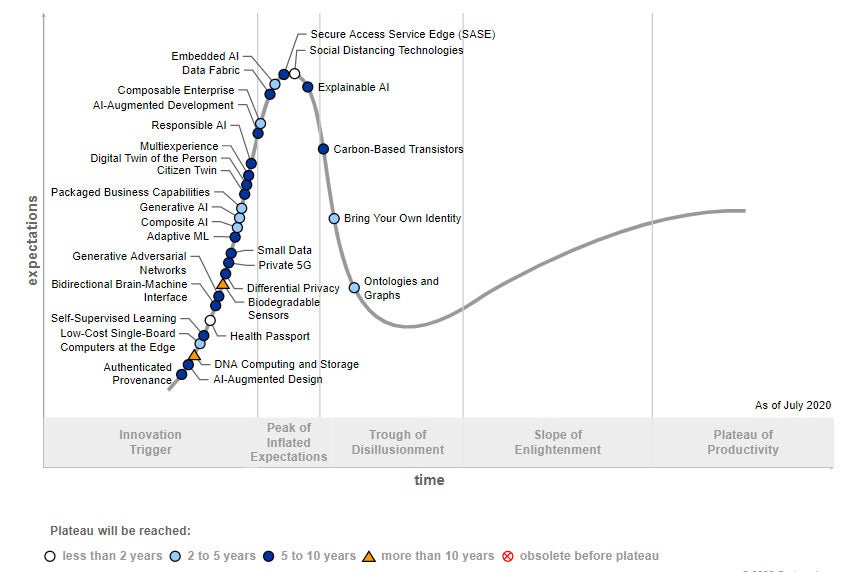
The trends likely to drive technology innovation in the next decade have been identified by Gartner, an S&P 500 research and advisory company, in its latest Hype Cycle.
The Hype Cycle for Emerging Technologies is Gartner’s methodology tool for visualising the newest technology trends, framing them in terms of what level of hype surrounds them.
Technologies typically gain early momentum, before hitting their peak and then falling into what Gartner calls the “trough of disillusionment” where hype fails to meet reality. Then then ultimately see a modest rise to find their place in the wider technology ecosystem, known as the “plateau of productivity”.
However, while most take several years, if not over a decade, to move through these stages, the coronavirus has changed the game in terms of technology adoption.
 Covid-19 changes the game for technology in Gartner Hype cycle
Covid-19 changes the game for technology in Gartner Hype cycle
Among the emerging trends highlighted by Gartner is this year’s Hype Cycle is Digital Me, which covers social distancing technologies and health passports, and which it predicts will reach the plateau of productivity in less than two years.
This reflects the rapid and transformational impact Covid-19 is having on technology.
How well do you really know your competitors?
Access the most comprehensive Company Profiles on the market, powered by GlobalData. Save hours of research. Gain competitive edge.

Thank you!
Your download email will arrive shortly
Not ready to buy yet? Download a free sample
We are confident about the unique quality of our Company Profiles. However, we want you to make the most beneficial decision for your business, so we offer a free sample that you can download by submitting the below form
By GlobalData“Technologies rarely enter the Hype Cycle at the point where social distancing technologies has entered it, but this technology has received extraordinary attention in the media, mainly because of privacy concerns,” says Brian Burke, research vice president at Gartner.
Health passports have penetrated the market at 5-20%, as the technology is required for access to public spaces and transportation in China and India, where it is used by hundreds of millions of people.
Other forms of Digital Me technology include digital twins of people’s health data, a governance variant known as citizen twin, multi experience and two-way brain-machine interfaces.
This trend demonstrates how technology now creates opportunities for digital representations of ourselves, in both digital and physical spaces.
“Technology innovation leaders must understand the opportunities for these technologies,” Burke added.
Emerging trends beyond Covid
Away from Digital Me, Gartner has also highlighted four other technologies that are making waves.
One is composite architecture, which covers technologies can quickly adapt or scale as businesses need, and include built-in artificial intelligence (AI), private 5G and low-cost edge computing
Continuing the theme of adaptation, Gartner has highlighted formative AI technology, which covers AI technologies that provide the means to use AI to adapt to changing needs. Among these are adaptive machine learning, generative AI and generative adversarial networks.
Algorithmic trust has been also been identified to ensure privacy and security of data, determine the source of assets and identity of individuals and devices within networks to assure trust is maintained within businesses, customers and employees.
Finally, Gartner has identified ‘beyond silicon’ as a final key trend. For some time, Moore’s Law has guided the IT industry, but technology is beginning to reach the physical limits of silicon and new materials are creating opportunities for smaller and faster technologies. Among these are DNA computing, biodegradable sensors and carbon-based transistors.
“Emerging technologies are disruptive by nature, but the competitive advantage they provide is not yet well known or proven in the market,” said Burke.
“Most will take more than five years, and some more than 10 years, to reach the plateau of productivity.”
Read more: Professional jobs see resurgence after Covid slump


 Covid-19 changes the game for technology in Gartner Hype cycle
Covid-19 changes the game for technology in Gartner Hype cycle
